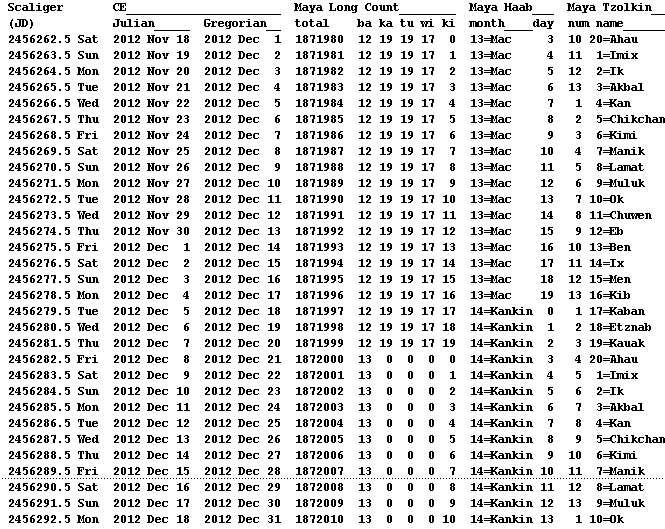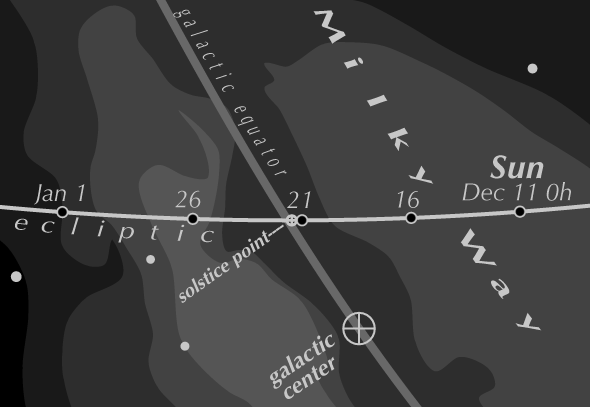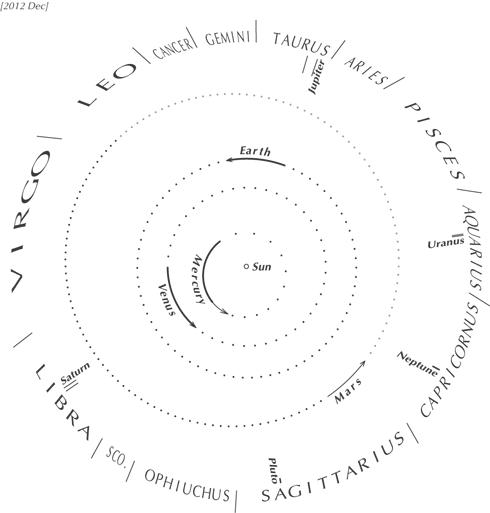|
The Maya Calendar and the "End of Time"
The Maya civilization, which flourished in southern Mexico, Guatemala, and Belize from about 2000 BC to 1000 AD, had a system of three calendars (fully described for the cover picture of Astronomical Calendar 2010):
— The Long Count, or numbering of days from (probably) 3114 BC Sep. 7: 20 kin (days) make a winal; 18 winal, a tun (360 days); 20 tun, a katun; 20 katun, a baktun (144,000 days, about 394 years). Even larger units were not actually used in the expression of dates: 20 baktun make a piktun (2,880,000 days); 20 piktun, a kalabtun; 20 kalabtun, a kinchiltun; 20 kinchiltun, an alautun (23,040,000,000 days, or around 63 million years).
— Haab, in which a 365-day year was divided into 18 20-day units with names (Pop, Wo, Zip, Zotz, Tzek, Xul, Yaxkin, Mol, Chen, Yax, Zak, Keh, Mak, Kankin, Muwan, Pax, Kayab, Kunku) and a 5-day 19th (Wayeb).
— Tzolkin, in which each day had one of 13 numbers, and also one of 20 names (Imix, Ik, Akbal, Kan, Chikchan, Kimi, Manik, Lamat, Muluk, Ok, Chuwen, Eb, Ben, Ix, Men, Kib, Kaban, Etznab, Kawak, Ahau), so that any one combination, such as 1 Imix, came around after a cycle of 260 days.
Some of these numberings started not with 1 but with zero; thus katun 19 is really the 20th in its baktun, and is followed by katun 0, which is the first in the next baktun.
The Scare
Between 2012 Dec. 20 and 21 of our calendar, the Long Count rolls into “a string of zeros, like the odometer turning over on your car,” as E.C. Krupp put it in his amusing article about “The Great 2012 Scare,” for the November 2009 issue of Sky & Telescope. This is the end of one baktun and the beginning of another; so its component katuns, tuns, winals and kins all start again at 0. According to some authorities, the first baktun was 0, and the baktun now ending is 12; according to others it is 13. Either way, it is the 13th since the start-date of the Long Count.
What the 2012 Scaremongers claim is:
— The end of this 13th 144,000-day baktun is the end of the Mayan calendar, or of a major cycle in it.
— “Thirteen was a sacred number for the Maya.”
— Also on 2012 Dec. 21 the Sun comes to its winter solstice point; and, in 2012, that point will be “aligned with,” indeed will “eclipse,” the center of our Milky Way galaxy.
— It will be the dawn of the “Age of Aquarius,” too, when precession brings the March equinox point or “First Point of Aries” from Pisces into Aquarius.
— And, for good measure, the planets will on that date be “lined up.”
— All this will cause our planet to be devastated, or possibly renewed. (By any or all of many imaginable drastic mechanisms: flood, earthquake, cosmic impact, nuclear war, electromagnetic fields, spiritual energy?)
— The Maya foresaw this, and that's why, inventing their calendar sometime after 200 AD, they set the starting-date for their Long Count where they did in 3114 BC. Apparently they knew that time would reach an “end” exactly 1,872,000 days after that date.
— And, to quote one of the commentators: .“..humanity is creating its own ecological disasters and desperately needs ancient indigenous wisdom.”
Well . . .
The most obvious flaw is that the
end of the 13th baktun is no more significant than the end of the
12th (on 1618 Sep. 17) or the 14th. The next larger cycle, piktun,
is composed not of 13 but of 20 baktun. The Maya did apparently
believe that the world is destroyed and remade at the turn of each
piktun. (Our present world, then, would date from 3114 BC.) But
there will be 7 more baktun — 7 times 144,000 days, or about
2,760 years — till the end of the current piktun.
Comparative calendars for December 2012. The first column is
the Julian Date (used in all astronomical calculations, and invented
in 1582 by Julius Scaliger). Then our day names, and “Christian
Era” calendar dates, in the Julian or “Old Style”
and the modern Gregorian. Then the Long Count, first as a total
of days since its start, then in its units of baktun, katun, tun,
winal, kin. Then the Haab “month” names and day numbers;
then the Tzolkin concurrent cycles of numbers and names.

There may be a more plausible scare in our year 4772, when baktun
19 ends.

As to whether the number 13 was “sacred”:
in Maya arithmetic, and certainly in the calendar systems, the dominant
number is 20. In the Long Count all the factors are 20, except for
one use of 18 to produce a unit (360 days) near to the seasonal
year. In Haab, too, the factors are 20 and 18; only in Tzolkin,
20 and 13.
What about the December solstice?
It is the moment when the Earth's north pole is tilted most away
from the Sun (giving midwinter for our northern hemisphere, midsummer
for the southern). The Sun appears to travel along the ecliptic,
a great circle that has to cross every other great circle at two
points, and one of these great circles is the galactic equator,
or midline of the Milky Way. In 2012 the instant of the solstice
is Dec. 21 11h 12m Universal Time. The solstice point, like all
points on the ecliptic, moves slowly westward (rightward), by about
1/72 of a degree per year, because of precession. The claim is that
in 2012 it will have arrived at the exact point where the ecliptic
crosses the galactic equator. This will last have happened 25,800
years ago (the length of the precessional cycle).

This might be true (more probably
not: I figure the solstice point actually passed across the galactic
equator in 1998). But it would be true in the same sense as being
in the precise center of a river, or of a hank of cotton wool. The
galactic equator is the midline of the Milky Way as seen from Earth.
The Milky Way's edges fade outward like those of a cloud of steam.
(The midline is partly traced, also irregularly, by dark dust-clouds.)
The galactic equator, used by astronomers for specifying positions
of objects in the galaxy, is defined by convention, and has been
defined in at least two ways (the “old” or “Ohlson”
and the “new” or “IAU”). It is not entirely
arbitrary, because one point on it, the radio source at the galaxy's
center, is known. The equator represents roughly the mid-plane of
the galaxy as we look out through its vast disk of stars. But the
Sun is thought to lie now about 26 light years north of the physical
mid-plane; so it is a plane in which we do not ourselves lie.
And the point where the ecliptic crosses
the galactic equator is not “the center of the galaxy.”
That is about 6.6 degrees southwest along the galactic equator.
So the half-degree-wide Sun is never in the same direction as —
can never “eclipse” — that center. (It is a degree
or so nearer a couple of days earlier.)
And what possible effect could there
be on a planet at that moment just because its north pole is tipped
in a certain direction away from its star? The center of the galaxy
is about 28,000 light years away — nearly 2 million times as
far from us as the Sun. Imagine two specks of soil in your yard,
an inch apart, going into convulsions because of the influence of
a stone 28 miles away, when there are billions of other bits of
soil between.
The “Age of Aquarius” has
been a fad since the 1960s. But it has yet to begin: the equinox
point will not reach Aquarius till some centuries ahead (in 2597,
as the constellation boundaries are defined by astronomy; and roughly
the same time, if they are all 30 degrees wide as in astrology).
And the Maya did not use our twelve constellations of the zodiac.
Nor had they any knowledge of the phenomenon of precession, which
moves the constellations in relation to the seasons.
And will the planets be “aligned”
in December 2012? No, they will be scattered in random directions.
Here is the solar system diagram for December from Astronomical
Calendar 2012. Nothing is near to being lined up with Earth
and Sun except the dwarf planet Pluto.

As for “ancient indigenous wisdom”:
the Maya of more than a thousand years ago were remarkably clever
but not outstandingly wise. Maya civilization collapsed from about
900 AD onward because of ecological foolishness, chronic wars between
petty states, a luxurious and cruel ruling elite, and a religion riddled
with human sacrifice. Population crashed, and when Europeans arrived
the cities were ruins lost in sparsely inhabited jungle. If the Maya
didn't see that coming, they are unlikely to have made reliable predictions
about the world of centuries later.
Worry about the very real damage to
our planet from human over-consumption (www.UniversalWorkshop.com/climate.htm).
Don't worry about yet another in the long line of panics concocted
by pseudo-scientists.
Just a few of the other scares
Soon: end of the world, according
to Michel Nostradamus. His Prophecies (1555) do not mention
the end of the world, but are taken to imply it at any time.
1844 Oct. 22: apocalypse and second
advent of Christ, according to Samuel S. Snow, a Millerite preacher;
William Miller himself had specified only the year. Thousands gave
away all their possessions. The day became known as The Great Disappointment.
1954 Dec. 22: end of the world, as
revealed by aliens to a Scientologist follower of L. Ron Hubbard.
Believers gathered at her house to await the spaceships, removing
metal from their clothes to avoid radiation. God, impressed by their
foresight, spared them.
1982 March 10: the Jupiter Effect,
a line-up of the planets, would cause catastrophes including a great
earthquake on the San Andreas Fault, according to a book by astronomers
Gribbin and Plagemann, who should have known better. The planets
did not line up.
1982, “by the end of”: God
would pass “judgment on the world,” according to televangelist
Pat Robertson.
1997 March 26: end of the world, according
to the Heaven's Gate cult of San Diego. Led by Marshall Applewhite,
39 of them committed suicide in order to join an alien spaceship
they thought was following Comet Hale-Bopp.
1999: Second Coming, according to
one of the more endearing and prolific of my correspondents, Greg
Jarboe.
2011 May 21, 6 p.m. California time:
Second Coming, “rapture” to heaven of 2 percent and fire
for the rest, according to radio preacher Harold Camping, based
on complex Biblical numerology. When it didn't happen, he moved
the date to October 21.
BACK
|




